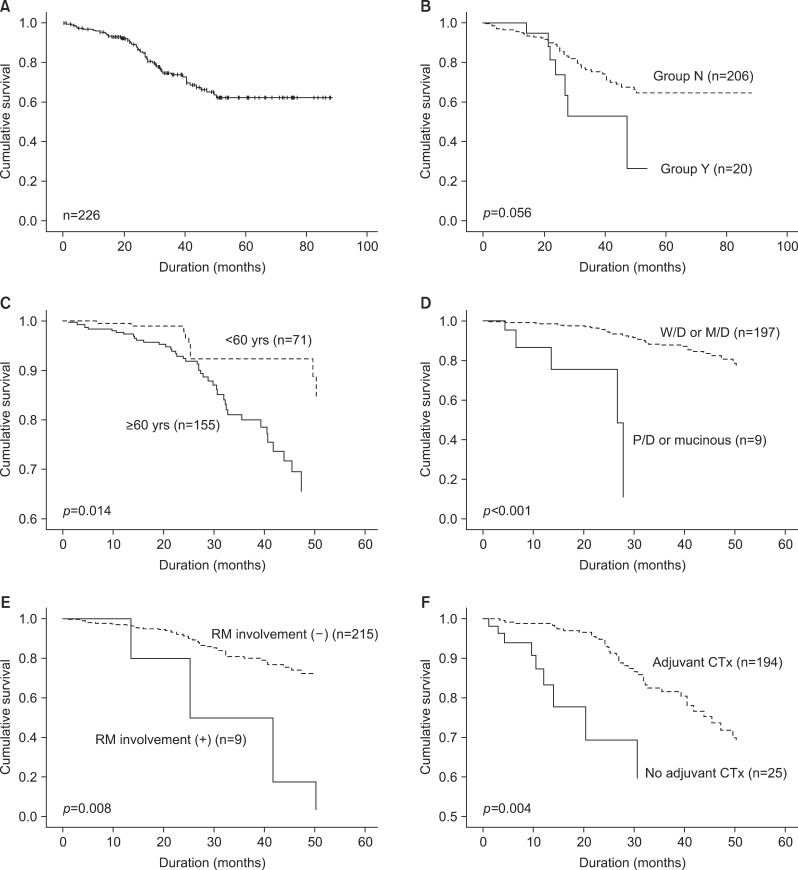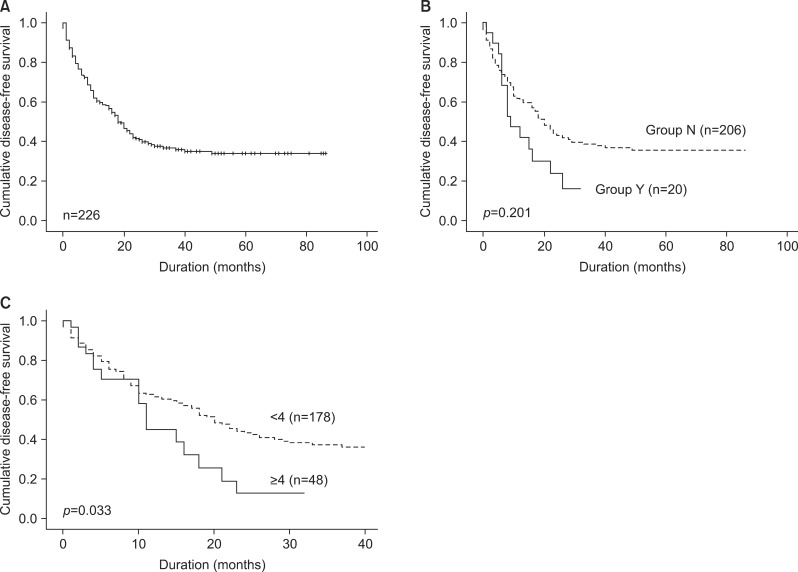Korean J Hepatobiliary Pancreat Surg.
2011 Nov;15(4):206-217. 10.14701/kjhbps.2011.15.4.206.
Is neoadjuvant chemotherapy necessary for patients with initially resectable colorectal liver metastases in the era of effective chemotherapy?
- Affiliations
-
- 1Department of Surgery, Seoul National University College of Medicine, Seoul, Korea. gsleenj@hanmail.net
- KMID: 2244127
- DOI: http://doi.org/10.14701/kjhbps.2011.15.4.206
Abstract
- BACKGROUNDS/AIMS
Hepatic resection has only guaranteed long-term survival in patients with colorectal liver metastasis (CRLM) even in the era of effective chemotherapy. The definite role of neoadjuvant chemotherapy (NCT) is to improve outcomes of unresectable CRLMs, but it its role has not been defined for initially resectable CRLMs (IR-CRLMs).
METHODS
We reviewed the medical records of 226 patients, who had been diagnosed and treated for IR-CRLM between 2003 and 2008; the patients had the following pathologies: 10% had more than 4 nodules, 11% had tumors larger than 5 cm, and 61% had synchronous CRMLs. Among these patients, 20 patients (Group Y) were treated with NCT, and 206 (Group N) did not receive NCT according to their physician's preference. The median follow-up time was 34.1 months.
RESULTS
The initial surgical plans were changed after NCT to further resection in 20% and to limited resection in 10% of 20 patients. Complication rates of Groups Y (30%) were indifferent from Group N (23%) (p=0.233), but intraoperative transfusions were more frequent in Group N (15%) than in Group Y (5%) (p=0.006). There was one case of hospital mortality (0.44%). Disease-free survival rates in Groups Y and N were 23% and 39%, respectively, and patient survival rates were 42% and 66% (p>0.05). By multivariate analysis, old age (> or =60 years), differentiation of primary tumor (poorly/mucinous), resection margin involvement, and no adjuvant chemotherapy were associated with poor patient survival; the number of CRLMs (> or =4) was associated with poor disease-free survival.
CONCLUSIONS
NCT had neither a positive impact nor a negative impact on survival, even with intraoperative transfusion, as observed on operative outcomes for patients with IR-CRLM. Further study is required to elucidate the role of NCT for treatment of patient with IR-CRLMs.
Keyword
MeSH Terms
Figure
Reference
-
1. Fong Y, Fortner J, Sun RL, Brennan MF, Blumgart LH. Clinical score for predicting recurrence after hepatic resection for metastatic colorectal cancer: analysis of 1001 consecutive cases. Ann Surg. 1999; 230:309–318. PMID: 10493478.2. Nordlinger B, Guiguet M, Vaillant JC, et al. Association Française de Chirurgie. Surgical resection of colorectal carcinoma metastases to the liver. A prognostic scoring system to improve case selection, based on 1568 patients. Cancer. 1996; 77:1254–1262. PMID: 8608500.
Article3. Scheele J, Stang R, Altendorf-Hofmann A, Paul M. Resection of colorectal liver metastases. World J Surg. 1995; 19:59–71. PMID: 7740812.
Article4. House MG, Ito H, Gönen M, et al. Survival after hepatic resection for metastatic colorectal cancer: trends in outcomes for 1,600 patients during two decades at a single institution. J Am Coll Surg. 2010; 210:744–752. 752–755. PMID: 20421043.
Article5. Kopetz S, Chang GJ, Overman MJ, et al. Improved survival in metastatic colorectal cancer is associated with adoption of hepatic resection and improved chemotherapy. J Clin Oncol. 2009; 27:3677–3683. PMID: 19470929.
Article6. Rees M, Tekkis PP, Welsh FK, O'Rourke T, John TG. Evaluation of long-term survival after hepatic resection for metastatic colorectal cancer: a multifactorial model of 929 patients. Ann Surg. 2008; 247:125–135. PMID: 18156932.7. Choti MA, Sitzmann JV, Tiburi MF, et al. Trends in long-term survival following liver resection for hepatic colorectal metastases. Ann Surg. 2002; 235:759–766. PMID: 12035031.
Article8. Minagawa M, Makuuchi M, Torzilli G, et al. Extension of the frontiers of surgical indications in the treatment of liver metastases from colorectal cancer: long-term results. Ann Surg. 2000; 231:487–499. PMID: 10749608.9. Ueno H, Mochizuki H, Hatsuse K, Hase K, Yamamoto T. Indicators for treatment strategies of colorectal liver metastases. Ann Surg. 2000; 231:59–66. PMID: 10636103.
Article10. Hurwitz H, Fehrenbacher L, Novotny W, et al. Bevacizumab plus irinotecan, fluorouracil, and leucovorin for metastatic colorectal cancer. N Engl J Med. 2004; 350:2335–2342. PMID: 15175435.
Article11. Saltz LB, Cox JV, Blanke C, et al. Irinotecan Study Group. Irinotecan plus fluorouracil and leucovorin for metastatic colorectal cancer. N Engl J Med. 2000; 343:905–914. PMID: 11006366.
Article12. de Gramont A, Figer A, Seymour M, et al. Leucovorin and fluorouracil with or without oxaliplatin as first-line treatment in advanced colorectal cancer. J Clin Oncol. 2000; 18:2938–2947. PMID: 10944126.
Article13. Goldberg RM, Sargent DJ, Morton RF, et al. A randomized controlled trial of fluorouracil plus leucovorin, irinotecan, and oxaliplatin combinations in patients with previously untreated metastatic colorectal cancer. J Clin Oncol. 2004; 22:23–30. PMID: 14665611.
Article14. Andres A, Toso C, Moldovan B, et al. Complications of elective liver resections in a Center With Low mortality: a simple score to predict morbidity. Arch Surg. 2011; (in press).15. Kamiyama T, Nakanishi K, Yokoo H, et al. Perioperative management of hepatic resection toward zero mortality and morbidity: analysis of 793 consecutive cases in a single institution. J Am Coll Surg. 2010; 211:443–449. PMID: 20822741.
Article16. Huang ZQ, Xu LN, Yang T, et al. Hepatic resection: an analysis of the impact of operative and perioperative factors on morbidity and mortality rates in 2008 consecutive hepatectomy cases. Chin Med J (Engl). 2009; 122:2268–2277. PMID: 20079125.17. Pang YY. The Brisbane 2000 terminology of liver anatomy and resections . HPB (Oxford). 2000; 2:333–339.18. Dindo D, Demartines N, Clavien PA. Classification of surgical complications: a new proposal with evaluation in a cohort of 6336 patients and results of a survey. Ann Surg. 2004; 240:205–213. PMID: 15273542.19. Eiber M, Fingerle AA, Brügel M, Gaa J, Rummeny EJ, Holzapfel K. Detection and classification of focal liver lesions in patients with colorectal cancer: Retrospective comparison of diffusion-weighted MR imaging and multi-slice CT. Eur J Radiol. 2011; (in press).
Article20. Shinya S, Sasaki T, Nakagawa Y, Guiquing Z, Yamamoto F, Yamashita Y. The efficacy of diffusion-weighted imaging for the detection of colorectal cancer. Hepatogastroenterology. 2009; 56:128–132. PMID: 19453043.21. O'Rourke TR, Welsh FK, Tekkis PP, et al. Accuracy of liver-specific magnetic resonance imaging as a predictor of chemotherapy-associated hepatic cellular injury prior to liver resection. Eur J Surg Oncol. 2009; 35:1085–1091. PMID: 19246171.22. Blyth S, Blakeborough A, Peterson M, Cameron IC, Majeed AW. Sensitivity of magnetic resonance imaging in the detection of colorectal liver metastases. Ann R Coll Surg Engl. 2008; 90:25–28. PMID: 18201494.
Article23. Nomura K, Kadoya M, Ueda K, Fujinaga Y, Miwa S, Miyagawa S. Detection of hepatic metastases from colorectal carcinoma: comparison of histopathologic features of anatomically resected liver with results of preoperative imaging. J Clin Gastroenterol. 2007; 41:789–795. PMID: 17700429.24. Kuker RA, Mesoloras G, Gulec SA. Optimization of FDG-PET/CT imaging protocol for evaluation of patients with primary and metastatic liver disease. Int Semin Surg Oncol. 2007; 4:17. PMID: 17623095.
Article25. Titu LV, Breen DJ, Nicholson AA, Hartley J, Monson JR. Is routine magnetic resonance imaging justified for the early detection of resectable liver metastases from colorectal cancer? Dis Colon Rectum. 2006; 49:810–815. PMID: 16741638.
Article26. Löwenthal D, Zeile M, Lim WY, et al. Detection and characterisation of focal liver lesions in colorectal carcinoma patients: comparison of diffusion-weighted and Gd-EOB-DTPA enhanced MR imaging. Eur Radiol. 2011; 21:832–840. PMID: 20886339.
Article27. Rappeport ED, Loft A. Liver metastases from colorectal cancer: imaging with superparamagnetic iron oxide (SPIO)-enhanced MR imaging, computed tomography and positron emission tomography. Abdom Imaging. 2007; 32:624–634. PMID: 17710359.
Article28. Vidiri A, Carpanese L, Annibale MD, et al. Evaluation of hepatic metastases from colorectal carcinoma with MR-superparamagnetic iron oxide. J Exp Clin Cancer Res. 2004; 23:53–60. PMID: 15149151.29. Furuhata T, Okita K, Tsuruma T, et al. Efficacy of SPIO-MR imaging in the diagnosis of liver metastases from colorectal carcinomas. Dig Surg. 2003; 20:321–325. PMID: 12806198.
Article30. Hagspiel KD, Neidl KF, Eichenberger AC, Weder W, Marincek B. Detection of liver metastases: comparison of superparamagnetic iron oxide-enhanced and unenhanced MR imaging at 1.5 T with dynamic CT, intraoperative US, and percutaneous US. Radiology. 1995; 196:471–478. PMID: 7617863.
Article31. Wanebo HJ, Berz D. The neoadjuvant therapy of colorectal hepatic metastases and the role of biologic sensitizing and resistance factors. J Surg Oncol. 2010; 102:891–897. PMID: 21165990.
Article32. Gomez D, Morris-Stiff G, Toogood GJ, Lodge JP, Prasad KR. Interaction of tumour biology and tumour burden in determining outcome after hepatic resection for colorectal metastases. HPB (Oxford). 2010; 12:84–93. PMID: 20495651.
Article33. Yasui K, Hirai T, Kato T, et al. A new macroscopic classification predicts prognosis for patient with liver metastases from colorectal cancer. Ann Surg. 1997; 226:582–586. PMID: 9389391.
Article34. Karanjia ND, Lordan JT, Quiney N, Fawcett WJ, Worthington TR, Remington J. A comparison of right and extended right hepatectomy with all other hepatic resections for colorectal liver metastases: a ten-year study. Eur J Surg Oncol. 2009; 35:65–70. PMID: 18222623.
Article35. Ferrero A, Vigan L, Lo Tesoriere R, Russolillo N, Sgotto E, Capussotti L. Bisegmentectomies as alternative to right hepatectomy in the treatment of colorectal liver metastases. Hepatogastroenterology. 2009; 56:1429–1435. PMID: 19950805.36. Torzilli G, Donadon M, Marconi M, et al. Systematic extended right posterior sectionectomy: a safe and effective alternative to right hepatectomy. Ann Surg. 2008; 247:603–611. PMID: 18362622.37. Gold JS, Are C, Kornprat P, et al. Increased use of parenchymal-sparing surgery for bilateral liver metastases from colorectal cancer is associated with improved mortality without change in oncologic outcome: trends in treatment over time in 440 patients. Ann Surg. 2008; 247:109–117. PMID: 18156930.38. Elias D, Baton O, Sideris L, et al. Hepatectomy plus intraoperative radiofrequency ablation and chemotherapy to treat technically unresectable multiple colorectal liver metastases. J Surg Oncol. 2005; 90:36–42. PMID: 15786433.
Article39. Wong R, Cunningham D, Barbachano Y, et al. A multicentre study of capecitabine, oxaliplatin plus bevacizumab as perioperative treatment of patients with poor-risk colorectal liver-only metastases not selected for upfront resection. Ann Oncol. 2011; 22:2042–2048. PMID: 21285134.
Article40. Karasaki T, Sano K, Takamoto T, et al. Complete resection of unresectable liver metastases from colorectal cancer without deterioration of liver function after cetuximab and irinotecan: two case reports. Hepatogastroenterology. 2010; 57:1526–1528. PMID: 21443115.41. Garufi C, Torsello A, Tumolo S, et al. Cetuximab plus chronomodulated irinotecan, 5-fluorouracil, leucovorin and oxaliplatin as neoadjuvant chemotherapy in colorectal liver metastases: POCHER trial. Br J Cancer. 2010; 103:1542–1547. PMID: 20959822.
Article
- Full Text Links
- Actions
-
Cited
- CITED
-
- Close
- Share
- Similar articles
-
- Curative Resection Following Neoadjuvant Chemotherapy Including a Molecularly Targeted Agent in Patients with Unresectable Colorectal Distant Metastases
- Liver Metastases in Colorectal Cancer
- Neoadjuvant and Adjuvant Treatments for Resectable and Borderline Resectable Pancreatic Ductal Adenocarcinoma: The Current Status of Pancreatic Ductal Adenocarcinoma Treatment in Japan
- Surgical Management of Colorectal Liver Metastases
- Recent advances in the treatment of patients with colorectal liver metastases



